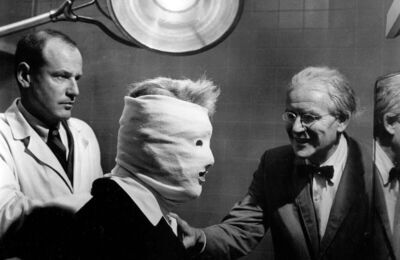Another Chance: On the Sustained Power of John Frankenheimer’s Seconds

John Frankenheimer’s “Seconds” will linger a lot longer than the title suggests in the mind of anyone who chooses to watch it. In fact, it might be one of the most haunting American films to come out of the 1960s, or any decade for that matter. James Wong Howe’s expressionistic cinematography plays a huge part in making this nightmarish vision so memorable. His work was deservingly nominated for an Academy Award, despite the film’s poor reception at the time of its release. Howe uses many different angles, techniques, and lenses to visualize this story, and the opening scene alone makes inventive use of the stead-cam, a distorted 9.7mm fish-eye lens, and plenty of tilted low-angle shots.
The photography instantly puts viewers at unease. It feels like the camera itself is having an out of body experience, which is fitting given the central theme of this cult classic deals with rebirth and fabricated reincarnation. After receiving a call from an old friend who was once thought to be deceased, Arthur Hamilton (John Randolph) gets talked into leaving his old life behind to lead a youthful one. His friend tells him about this company that can grant you a second life. If you still haven’t seen this film, I recommend doing so before continuing to read on, as I’ll discuss the film’s philosophical themes.

Once Hamilton gets lured into this dark underground world, there’s no turning back. The company blackmails him into paying for the procedure. He has no other choice. First, they fake his death, then transform the way he looks, and finally they reintegrate him into society with a new job and a new identity. Although the premise itself sounds miraculous for the old man, it’s quite ironic that his existential crisis occurs after the procedure is done not before. Perhaps, “rebirth” only succeeds when an internal awakening sparks the need for a transformation beforehand.
There’s a great scene midway through the film, when the younger version of himself, now played by Rock Hudson, attends a free-spirited festival. Everyone starts to take their clothes off, and they begin stomping grapes while drinking wine. It’s a pivotal moment in terms of character development, yet very few words are ever spoken. It’s quite clear that our main character or “second” feels very uncomfortable by the bohemian nature of this generation. After all, he is an old man in a young man’s body, and he is clearly part of a much more conservative generation. When we were young, we wanted to grow up. When we grew up, we wanted to be children again. Maybe, we would accept the idea of aging if we considered that the times change too.
Frankenheimer’s masterpiece grows in stature with each passing year due the relevant themes of existentialism, and free-will. But much like the main character, the film starts off as one thing, reinvents itself, and becomes something else entirely in the brutal, yet necessary, final moments. In a span of a few seconds, it evolves into a film about the devastating inhumanity caused by corporate greed. The fictional company uses tactics that are very much in line with what is practiced today by mega-corporations. “The Company” uses a referral program as its recruiting strategy to encourage more clients to join the false promises of a second chance at life. Customers get rewarded for each new user that signs up, so they very much become a slave to the system. Only this time, each referral is a matter of life and death, so everyone involved is gambling with the lives of others. In 1966, this premise may come off as dystopian, but today, with thousands of lives dying at sweatshops all around the world, the idea of big corporations sacrificing human lives for profit isn’t that far-fetched at all.

Frankenheimer’s third entry of the “paranoid” trilogy also taps into the relationship between physical appearance and personality in a psychological exploration of identity. Does your personality influence your appearance, or does the way you look have a direct effect on the way you are? Through the physical transformation from Arthur Hamilton to Antiochus Wilson, our main character alters not only his face but his vocal cords as well. After the drastic changes take place, I couldn’t help but notice that his demeanor and personality gradually changed too. He becomes more lively, confident, and outspoken, especially in the party sequence. The way people react to the way he looks has a direct effect on the way he responds to them.
In the scene where Wilson visits his former wife, Frankenheimer poses questions on the effects the procedure has on memory. Do the memories of his past self grow more distant the more he spends time as a second? Will they eventually feel like they belonged to another person, another man? Are his current actions and behavior being dictated by his old self or his second self? It’s fascinating how appearance has a direct impact on identity. Frankenheimer once explained, “What the picture really says is that you are who you are; as soon as you try to erase the past, you’re doomed.”
It is said that Frankenheimer included several shots of an actual rhinoplasty operation in the plastic surgery sequence, and when the cameraman fainted, he had to pick the camera up and finish the job himself. Not surprisingly, when it first screened, several viewers were spotted throwing up. Like Antonioni’s “L’Avventura,” Scorsese’s “Taxi Driver,” and Malick’s “The Tree of Life,” Frankenheimer’s “Seconds” was booed at the Cannes Film Festival for all the wrong reasons—for being way ahead of its time. And while it had a premature death on its initial release, in an ironic twist of fate, “Seconds” found poetic justice. Like its main character, it is reliving a second life.





